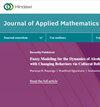A Recent Development of Numerical Methods for Solving Convection-Diffusion Problems
IF 1.3
Q2 MATHEMATICS, APPLIED
引用次数: 36
Abstract
Convection-Diffusion Problems occur very frequently in applied sciences and engineering. In this paper, the cru x of research articles published by numerous researchers during 2007-2011 in referred journals has been presented and this leads to conclusions and recommendations about what methods to use on Convection-Diffusion Problems. It is found that engineers and scientists are using finite element method, finite volu me method, finite volu me element method etc. in flu id mechanics. Here we discuss real life problems of fluid engineering solved by various numerical methods .which is very useful for finding solution of those type of governing equation, whose analytical solution are not easily found. Co mputational fluid dynamics is a branch of Engineering and science that,(1) with the help of d igital co mputers, produces quantitative prediction of fluid-flow phenomenon based on those conservation laws governing fluid mot ion. These predictions normally occur under those conditions defined in terms of flow geo metry. Convection- Diffusion Problems arises where fluid flow p lays a significant role .We must account for the effects of convection. Diffusion occurs always alongside convection in nature. The numerical solution of convection-diffusion transport problems arises in many important applications in science and engineering. These problems occur in many applications such as in the transport of air and ground water pollutants, oil reservoir flo w, in the modeling of semiconductors, and so forth(3). This paper describes several fin ite difference schemes for solving the convection-diffusion equation. Therefore; we examine computation methods to predict comb ined convection- diffusion equation. The convection-diffusion equation is a parabolic partial differential equation combin ing the diffusion equation and the advection equation, which describes physical phenomena where part icles or energy (or other physical quantities) are transferred inside a physical system due to two processes: diffusion and convection. In its simplest form (when the diffusion coefficient and the convection velocity are constant and there are no sources or sinks) the equation takes the form as following: 2 c D c v c t求解对流扩散问题数值方法的新进展
对流扩散问题在应用科学和工程中经常出现。在本文中,介绍了2007-2011年期间众多研究人员在参考期刊上发表的研究文章的要点,并由此得出结论,并建议使用什么方法来解决对流扩散问题。在流感力学中,工程师和科学家们正在使用有限元法、有限体积法、有限体积元法等。本文讨论了用各种数值方法求解的流体工程实际问题,这对于求解那些不易找到解析解的控制方程是非常有用的。计算流体动力学是工程和科学的一个分支,它:(1)在数字计算机的帮助下,根据控制流体运动的守恒定律对流体流动现象进行定量预测。这些预测通常发生在根据流动几何定义的条件下。对流-扩散问题出现在流体流动p起重要作用的地方,我们必须考虑对流的影响。在自然界中,扩散总是与对流同时发生。对流扩散输运问题的数值解在科学和工程中有许多重要的应用。这些问题出现在许多应用中,如空气和地下水污染物的输送、油藏流动、半导体建模等等(3)。本文介绍了求解对流扩散方程的几种有限差分格式。因此;我们研究了预测梳状对流-扩散方程的计算方法。对流扩散方程是扩散方程和平流方程结合的抛物型偏微分方程,它描述了部分粒子或能量(或其他物理量)在物理系统内通过扩散和对流两个过程传递的物理现象。在最简单的形式下(当扩散系数和对流速度恒定且没有源和汇时),方程的形式如下:2c D c v ct
本文章由计算机程序翻译,如有差异,请以英文原文为准。
求助全文
约1分钟内获得全文
求助全文
来源期刊

Journal of Applied Mathematics
MATHEMATICS, APPLIED-
CiteScore
2.70
自引率
0.00%
发文量
58
审稿时长
3.2 months
期刊介绍:
Journal of Applied Mathematics is a refereed journal devoted to the publication of original research papers and review articles in all areas of applied, computational, and industrial mathematics.
 求助内容:
求助内容: 应助结果提醒方式:
应助结果提醒方式:


